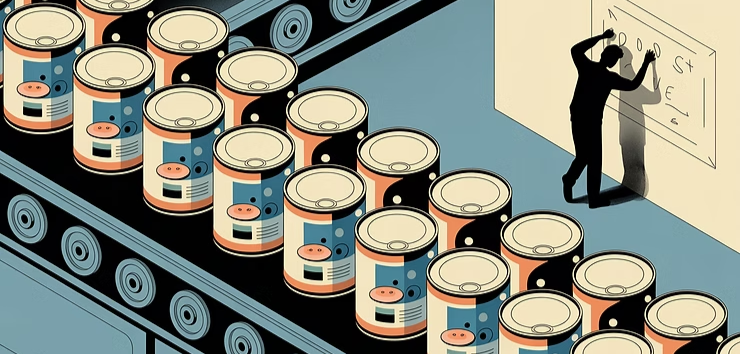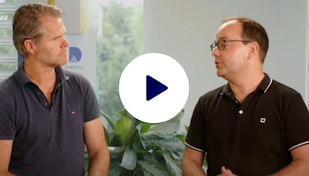Marketing production is becoming a commodity. And that’s a good thing.

Open your phone. Scroll Instagram. Look at the ads. The influencer promotions. The TikTok videos. Here’s the unsettling truth: most of them look pretty damn good.
And I don’t mean “good for a student project.” I mean good-good. Clean design. Polished copy. Nice photography. Some even better than what you’d expect from brands with budgets in the millions.
Now ask yourself: can you always tell which ones came from a global agency and which ones were made by a 22-year-old with a Canva subscription and a half-charged laptop?
Neither can I.
That’s the problem. And the opportunity.
For decades, “looking good” was the differentiator. Agencies thrived because they had the expensive tools, the expensive people, the expensive processes. If your creative looked polished, you stood out.
But that’s not the world we live in anymore.
Today, beauty is cheap. Templates, AI generators, stock libraries — they’ve democratized production. Anyone can make something that looks great.
And here’s the provocative truth: when everyone can make something great, greatness stops being valuable.
Production is becoming a commodity.
The old differentiator
I started my career in a world where “craft” was king.
You hired an agency because they had Adobe® Photoshop® when you didn’t. Because they knew how to light a studio shot. Because they could edit a TV ad in Avid when you were still fiddling with PowerPoint.
Looking good was scarce. And in business, scarcity = value.
That’s why agencies billed millions for campaigns. That’s why creative directors were treated like rock stars. That’s why the “wow” factor of a glossy print spread or a slick 30-second spot could carry a whole brand message.
The differentiator was production quality.
It was rare. It was hard. It was expensive.
So it was valuable.
The closing gap
Fast forward to today.
The tools that were once locked away in expensive studios are now sitting in every laptop, browser, and phone.
- Canva has 185 million users who can produce “agency-looking” social posts in minutes.
- Figma democratized design systems — anyone can collaborate, iterate, prototype.
- AI tools generate photo-realistic product shots or infinite variations of backgrounds in seconds.
- TikTok’s editing suite is powerful enough for what used to require Adobe Premiere.
The gap is closed.
A small brand can now make creative that looks just as good as a multinational — or at least good enough that most consumers won’t notice the difference.
When everyone can make something beautiful, beauty itself becomes cheap.
And when beauty becomes cheap, it becomes a commodity.
Commodities: a quick reminder
Electricity used to be a miracle.
Cities competed to show off their light bulbs. Having electricity was a mark of progress.
Now? Nobody wins market share because their office has electricity. We expect it. It’s invisible.
Same with WiFi. Same with water.
Once something is standardized and universally available, it stops being a differentiator. It just becomes the baseline.
That’s what’s happening to marketing production.
Production as the next commodity
Think about it.
When your competitor can produce an ad that looks 95% as good as yours — for 5% of the cost — what exactly are you competing on?
Not production. Not polish. Not beauty.
Because production is no longer scarce.
It’s becoming like electricity. Expected. Standardized. Invisible.
The real competition moves somewhere else.
The real differentiator
So if production is cheap, what matters?
- Speed. Not just speed to create one nice ad, but speed to launch thousands of assets across channels, correctly, on time.
- Governance. Making sure everything complies: legal disclaimers, brand rules, localization quirks. The unsexy stuff that keeps you alive.
- Adaptability. When prices change, when stock shifts, when regulations update — can your system pivot instantly?
Story. Not just looking good, but making sense. Connecting thousands of outputs into one coherent brand narrative.
Retail and FMCG marketers already live this reality. They don’t care about “one beautiful ad.” They care about 10,000 correct variants delivered by Tuesday.
Creative that scales without chaos is the new differentiator.
The AI acceleration
AI is pushing this into overdrive.
It doesn’t just make production cheaper. It makes it instant.
Need 40 resizes? Done in seconds.
Need a background swapped? Done in seconds.
Need multilingual copy versions? Done in seconds.
The grunt work — the resizing, reformatting, tweaking — is disappearing.
Which means the value isn’t in pressing the buttons anymore. It’s in what you feed the system:
- Clean product data.
- Clear brand rules.
- Smart orchestration.
That’s where competition lives now. Not in the polish of the output, but in the infrastructure behind it.
Humans, finally free
This is the part most people miss.
Commoditization sounds like a threat. But it’s actually liberation.
If production is a commodity, people stop being production machines.
No more designers spending nights resizing banners.
No more marketers babysitting version control.
No more interns copying disclaimers into 40 layouts.
Humans get to do the work only humans can do: inventing, storytelling, connecting, strategizing.
Production becoming a commodity isn’t the death of creativity. It’s the liberation of creativity.
The hard truth for agencies
This shift won’t be kind to everyone.
Agencies who sell “we make pretty things” will get crushed. Because everyone makes pretty things now.
The agencies that survive will be the ones who:
- Sell systems, not just outputs.
- Deliver clarity, not chaos.
- Focus on ideas, storytelling, orchestration.
- Treat production as plumbing, not as the prize.
Because beauty is cheap. But clarity, speed, and story are priceless.
Closing punch
So yes — marketing production is becoming a commodity.
That’s not bad news. That’s the best news.
Because when beauty is everywhere, the real differentiator shifts to the things that actually matter:
- Speed.
- Governance.
- Adaptability.
- Story.
Production won’t save you. But clarity will.
Creativity isn’t dead. It’s just moving up the value chain.
And the sooner we accept that, the sooner we can stop clinging to production as our value — and start building the systems and stories that actually set us apart.
Marketing production is the next commodity.
And thank God for that.
CEO insights
Kevin Goeminne
Sep 10, 2025


